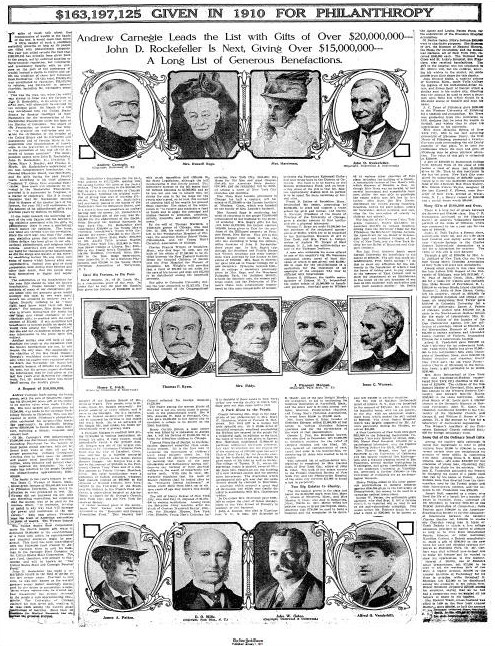 The New York Times of January 1, 1911, featured a review of the largest gifts within the $163 million dollars given to charity the year before. Take a stroll with me through 1910’s large-gift philanthropy.
The New York Times of January 1, 1911, featured a review of the largest gifts within the $163 million dollars given to charity the year before. Take a stroll with me through 1910’s large-gift philanthropy.
- The article presumes the largest gifts were made “with no purpose on the part of the possessors of wealth beyond a desire to relieve and uplift the condition of those less fortunate than themselves.” Well, there are a few counterexamples to the pure altruism theory and I mention them below.
- Education got 46% of the total giving and 19% went to religion. That’s very different than today. In 2008, Giving USA says religious charities received 35% of total giving compared to 13% for education. Religion has gotten the lion’s share of charitable gifts for many years running.
- There is speculation about how much John D. Rockefeller would contribute to his foundation the following year, with anticipation that a majority of his wealth would be directed there.
- There are multiple references to “returning wealth to the people,” as if wealth were a loan with expectation of repayment. That’s quite interesting.
- The wealthy who give anonymously are especially admired.
- Andrew Carnegie donated $3.5 million to Carnegie Technology Schools (now, Carnegie Mellon University, my alma mater), bringing to $23.5 million his total contribution to the college. That’s roughly $450 million in present value, inflation adjusted money.
- The largest charitable gift by will in 1910, Isaac Wyman’s $10 million bequest to Princeton, put the university “near the front of American universities in point of wealth.” It’s at or near the front today.
- Ten thousand acres on the Hudson River in New York from Mary Harriman created a family-named state park, which features prominently in my high school year book. It seems everybody but me enjoyed something “memorable” there.
- Separately, to receive a gift of $31,000 for a new train station, Turner, NY had to change its name to Harriman. That’s a little less than altruistic. The town acceded. How would that go over today? Bloomberg, NY?
- In another show of ego, James Scott willed $500,000 to Detrioit for a fountain, on the condition that it include a life size statue of him. Or was he modest, not insisting on a larger-than-life representation?
- Mrs. Mary Baker G. Eddy is the founder of Christian Science and willed $1 million in furtherance of the church.
- Here’s an unfortunate cultural insight: it is considered “remarkable” that an “invalid,” Miss Martha R. Hunt, could have sufficient savvy to quadruple the wealth that her father left her. Miss Hunt’s will left gifts to religion, hospitals and social services.
The Times says, “America’s men and women do not build for themselves . . .” That was mostly true in 1910 and I think–wealthy or modest–it’s mostly true today.
(I didn’t find this myself. I owe someone credit for bringing it to my attention, but I don’t remember who. Thank you, good person.)